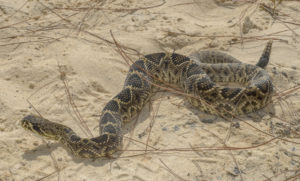Snakes
Poison control centers in Florida receive calls about snakebites year-round. While certain native species tend to be more active in spring, poison centers take calls from people who work with snakes or who encounter them in their natural habitat. Most species of snakes in Florida are nonvenomous, but any snake can bite. The six species of venomous snakes native to Florida are described in detail below.
Poison center callers can now send photos of their bite and/or the snake so that our poison specialists can immediately determine the type of snake involved. Calls involving snakebites often require immediate medical care and poison centers will work with the local hospital emergency staff to assess that patient and administer the correct anti-venom. For more information about snakes in Florida, visit the Florida Fish and Wildlife Conservation Commission.
Eastern Coral Snake
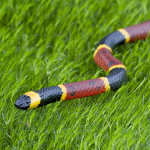 The Eastern Coral Snake is found throughout the State of Florida, with the exception of the southern Florida Keys. Ranging in size from 1.5 to 2.5 feet, these snakes commonly feed on lizards, snakes and frogs. They also tend to stay underground or beneath objects like logs.
The Eastern Coral Snake is found throughout the State of Florida, with the exception of the southern Florida Keys. Ranging in size from 1.5 to 2.5 feet, these snakes commonly feed on lizards, snakes and frogs. They also tend to stay underground or beneath objects like logs.
Coral snakes belong to the same family (Elapidae) as cobras, and as such, they lay eggs. Bright red and black rings stretch along the length of their bodies, with thin yellow rings separating the segments (the tails alternate between black and yellow). Smooth scales cover the entire body. The head has a blunt black nose.
Non-venomous Scarlet Kingsnake and Scarlet Snake are sometimes confused for coral snakes, because they have similar colors (red, black, and yellow or white) and patterns. However, in these two species, red touches only black; in coral snakes, red only touches yellow. Imagine the colors of a stoplight; if red and yellow are next to each other, it is a coral snake.
Possible Symptoms
Weakness, paralysis, slurred speech, difficulty talking, difficulty breathing.
First Aid
Go to emergency department immediately. Do not apply tourniquets. Do not apply ice. Do not cut the skin and suck the bite.
Cottonmouth/Water Moccasin
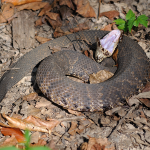 Often found in bodies of water, this venomous snake can be found throughout the State of Florida. The average adult stretches between two and four feet, with large adults sometimes reaching six feet in length. Named for the cotton-white mouth interior that this snake displays as a sign of defense, this member of the viper family gives birth to live young and often preys on small mammals like frogs, rats, mice, and fish.
Often found in bodies of water, this venomous snake can be found throughout the State of Florida. The average adult stretches between two and four feet, with large adults sometimes reaching six feet in length. Named for the cotton-white mouth interior that this snake displays as a sign of defense, this member of the viper family gives birth to live young and often preys on small mammals like frogs, rats, mice, and fish.
A juvenile Cottonmouth can easily be mistaken for a Copperhead snake, due to its bright rust-colored bands and yellow tail. As adults, the coloring of Cottonmouth snakes usually evolves to be dark brown or black, sometimes with a distinct crossband pattern.
Many water-dwelling snakes are not venomous; of course, it is always best to leave a water snake alone to reduce the risk of being bitten.
Possible Symptoms
Pain, swelling, vomiting, bruising, weakness, shock, metallic taste in the mouth.
First Aid
Remove jewelry and tight clothing near the bite. Keep the bit limb below heart level. Cleanse. Do not apply a tourniquet or ice, as these worsen the damage. Do not cut the skin and suck out venom. Go to the nearest hospital.
Eastern Diamondback Rattlesnake
The largest venomous snake in Florida, the Eastern Diamondback Rattlesnake is usually between three and six feet long (the longest snake of this species on record was eight feet long). Found statewide in pinelands, scrub, coastal barrier islands and even urban regions, these snakes feed on mammals like rodents and rabbits. Young Eastern Diamondbacks are venomous from the day they’re born.
An easily identifiable diamond pattern with beige borders and brown centers (hence the name) makes it easy to spot these snakes. Extreme care should be taken when an Eastern Diamondback is approached, as these snakes can strike up to two-thirds of their body lengths. This snake rattles its tail end when it feels threatened. Keeled scales give these snakes a rough appearance.
Possible Symptoms
Pain, swelling, vomiting, bruising, weakness, shock, metallic taste in the mouth.
First Aid
Remove jewelry and tight clothing near the bite. Keep the bit limb below heart level. Cleanse. Do not apply a tourniquet or ice, as these worsen the damage. Do not cut the skin and suck out venom. Go to the nearest hospital.
Pygmy Rattlesnake
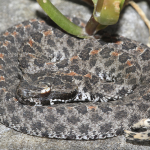 These tiny snakes, measuring only one to two feet in length on average, inhabit most of the state of Florida except the Keys. They’ve been spotted in tree-filled flatwoods, scrub, pinelands and palm hammocks, as well as urban areas and golf courses. These aggressive snakes mainly subsist on lizards and frogs, though they are known to strike if they feel threatened.
These tiny snakes, measuring only one to two feet in length on average, inhabit most of the state of Florida except the Keys. They’ve been spotted in tree-filled flatwoods, scrub, pinelands and palm hammocks, as well as urban areas and golf courses. These aggressive snakes mainly subsist on lizards and frogs, though they are known to strike if they feel threatened.
Pygmy rattlesnakes are marked by their grey appearance with dark, clay-colored patches. They also have a dark band that connects the eyes to the jaw. Beware that this snake’s rattle is often small and faint, making it difficult to hear even as it’s being vibrated.
Possible Symptoms
Pain, swelling, vomiting, bruising, weakness, shock, metallic taste in the mouth.
First Aid
Remove jewelry and tight clothing near the bite. Keep the bit limb below heart level. Cleanse. Do not apply a tourniquet or ice, as these worsen the damage. Do not cut the skin and suck out venom. Go to the nearest hospital.
Canebrake (Timber Rattlesnake)
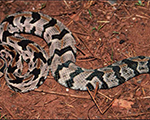 Found only in north Florida, these reptiles prefer moist areas and pine hammocks. They grow up to five feet long. Circumferential bands of dark markings look similar to other snakes, but there are two distinctive features: a red-brown stripe running the length of the back and the black tail.
Found only in north Florida, these reptiles prefer moist areas and pine hammocks. They grow up to five feet long. Circumferential bands of dark markings look similar to other snakes, but there are two distinctive features: a red-brown stripe running the length of the back and the black tail.
Possible Symptoms
Pain, swelling, vomiting, bruising, weakness, shock, metallic taste in the mouth.
First Aid
Remove jewelry and tight clothing near the bite. Keep the bit limb below heart level. Cleanse. Do not apply a tourniquet or ice, as these worsen the damage. Do not cut the skin and suck out venom. Go to the nearest hospital.
Copperhead
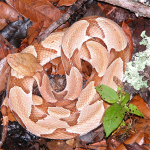 This north Florida snake is limited to a small area along the branches of the Appalachicola River. These copper-colored snakes only grow up to about three feet long. The flesh-colored bands alternate in darker and lighter shades. The juvenile snakes have similar colors with a yellow tail.
This north Florida snake is limited to a small area along the branches of the Appalachicola River. These copper-colored snakes only grow up to about three feet long. The flesh-colored bands alternate in darker and lighter shades. The juvenile snakes have similar colors with a yellow tail.
Possible Symptoms
Pain, swelling, vomiting, bruising, weakness, shock, metallic taste in the mouth.
First Aid
Remove jewelry and tight clothing near the bite. Keep the bit limb below heart level. Cleanse. Do not apply a tourniquet or ice, as these worsen the damage. Do not cut the skin and suck out venom. Go to the nearest hospital.


